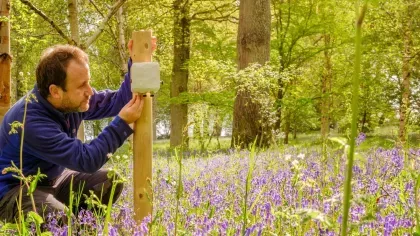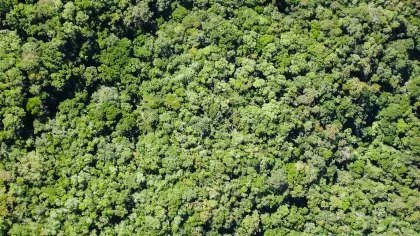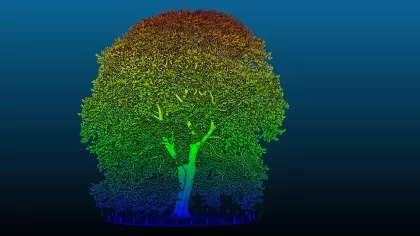28 October 2021
Nature-based solutions might just change the world
Can we protect, manage and restore our biodiversity by taking inspiration from nature’s genius to solve pressing issues like climate change, food insecurity and biodiversity loss?

Thanks to millennia of evolution, plants have done a pretty good job of adapting to survive a changing world.
In hurricane-prone areas, trees have adapted to resist the high-powered winds, protecting the delicate ecosystem they live in.
Forest fires can raze a landscape to the ground, but species like those in the genus Grevillea have adapted to withstand the flames.
Amidst a rapidly, dangerously changing climate and unsustainable land use, 2 in 5 plants are now threatened with extinction.
Our planet in peril
- 70% of wetlands have been lost in the last century.
- Mangroves are disappearing at the rate of 1% a year.
- Declining peatlands contribute to 6% of carbon dioxide emissions.
Considering that plants are the source of our food, medicines, and all that sustains and enhances human life, the race is on to protect them.
They are also balanced within delicate interactions within ecosystems like with soil, pollinators and fungi – lose one, and risk undermining the immediate world around it.
So, can we restore and protect nature and use its genius to provide solutions that benefit people, planet and biodiversity?

What are nature-based solutions?
Nature-based solutions is an umbrella concept for multiple interventions that work with nature to:
- protect and benefit the world’s biodiversity
- sustainably manage or restore ecosystems
- tackle social challenges to improve human wellbeing
They are crucial interventions that enable us to address climate change, boost biodiversity and provide a source of jobs, income, medicines, raw materials and food.
Importantly, nature-based solutions are most effective when led by meaningful, mutual collaboration with local communities where those plants are from.

Where do nature-based solutions exist?
Healthy natural ecosystems often provide enormous and wide-ranging benefits, from producing oxygen and clean water, to drawing down and storing carbon from our atmosphere into biomass and soils.
Restoring forests is a common example of a nature-based solution.
Whether tropical or temperate, forests act as carbon sinks, giving food and shelter for all types of creatures and enabling protection from flooding or the sun’s heat – as well as cleaning our water and providing our fuel.
Mangroves are another excellent natural asset that we can protect and restore to great benefit.
A rich spot for biodiversity, they give communities vital income from fishing and tourism. Found along the shore, they help manage the impact of storms and erosion, and their intricate roots help purify water.
Peatlands are one of the most impressive ecosystems giving us safe drinking water and acting as the largest natural terrestrial carbon store whilst providing food and fibres – but when they are destroyed, they can be a major source of greenhouse gas emissions.
Coastal dunes with their dune plants and vegetation cover both protect the land from erosion and help make those beach spots a hit with tourists.

Kew and nature-based solutions
Restoring, managing and protecting healthy ecosystems not only helps manage the carbon in our atmosphere but also improve a range of ecosystem services and the general wellbeing of the planet’s people.
That’s why we have embedded them in Our manifesto for change, our sustainability strategy and our science strategy.
Everyday our scientists work on projects around the world that contribute towards nature-based solutions:
1. In Peru, our team have investigated the potential of planting key tree species like Inga edulis, in areas of the Amazon converted for cattle pastures.
Introducing these trees provided food for the livestock and ‘living fences’ to lower costs and shade, all whilst increasing the lifespan of the grassland too and enabling better carbon sequestration.

2. Our scientific collaborations in Colombia are examining the Paramo ecosystems.
This amazingly useful biodiverse ecosystem sees plants act as sponges, sucking up the water from the ground or intercepting it from fog and enabling cities to have clean drinking water.

3. Working in Lebanon and Jordon, our scientists are restoring the sustainable use of traditional Eastern Mediterranean diet by conserving wild edible plants, and boosting the local biodiversity in orchards and abandoned terraces.
This provides an opportunity to enhance in-country livelihoods and promote nutrient-dense (as opposed to energy-dense) diets.

4. Whilst reforestation has major benefits, the wrong tree in the wrong place can be really damaging.
That’s why we’ve put together 10 golden rules for reforestation for professionals.

5. Our new Landscape Ecology Project at Wakehurst, Kew’s wild botanic garden in Sussex, is providing scientific evidence for UK nature-based solutions, to help tackle critical global challenges from climate change to biodiversity loss.

We know that we are in position to use our expertise to advocate for the world’s plants and take action to maintain a healthy and sustainable planet.
Why not play your own part with this list of actions to do in your everyday life?



